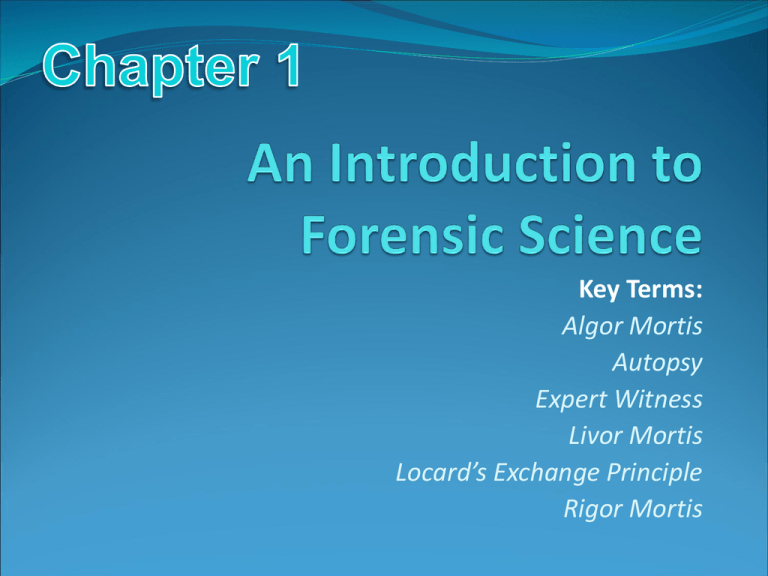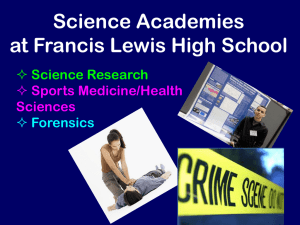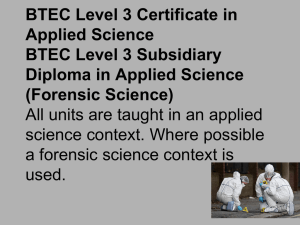
Key Terms:
Algor Mortis
Autopsy
Expert Witness
Livor Mortis
Locard’s Exchange Principle
Rigor Mortis
Forensic Science – An Intro
Forensic Science - a series of highly specialized
disciplines that rely on an array of sophisticated
technology for the investigation of everything from
biological fluids to fibers and drugs.
2
Definition
In its broadest definition, forensic science is the
application of science to criminal and civil laws.
The subject matter of this book emphasizes the
application of science to those criminal and civil laws
that are enforced by police agencies in a criminal justice
system.
Forensic science owes its origins to individuals such as
Bertillon, Galton, Lattes, Goddard, Osborn, and Locard,
who developed the principles and techniques needed to
identify or compare physical evidence.
3
Forensic Science – An Intro
Forensic Science – the
application of science to the
criminal & civil laws that are
enforced by police in a criminal
justice system
The scientific principles and
technology to the legal
process. It essentially
involves the
characterization and
examination of evidence.
Criminalistics – the SERVICES
of the crime laboratory itself.
Controlled substances
Serology
DNA
Trace Chemistry
Firearms
Toolmarks
Questioned Documents
Latent Prints
Toxicology
4
Intro to
Forensic
Science
Encompasses
many fields of
science
5
Forensic Science – An Intro
Forensic science can be classified in two manners:
It may be associative in
nature, which is linking
people, places or objects.
The well-known Locard
Principle ("Every contact
leaves a trace") relates to
associative evidence.
Associative evidence may
be sub-divided, for
example fingerprints or
DNA.
Much of the evidence that
comes from crime lab is
not associative, it is
inceptive. That is, it
addresses the issue of
whether an offence has
occurred. Controlled
substance analysis and
alcohol testing are
examples of inceptive
evidence.
6
Forensic Science – An Intro
Testing may produce evidence to exclude an
association (DNA types in recovered sperm may
differ from those of the suspect). If they do not
exclude the suspect then we are left with
corroborative evidence that supports but does not
prove the hypothesis of association.
7
Forensic Science – An Intro
5 Basic Services in ALL
Crime Labs
Optional Services
Toxicology
Biology Unit
Fingerprint analysis
Firearms Unit
Voiceprint analysis
Document Unit
Crime-scene
Physical Science Unit
investigation
Polygraph
administration
Photography Unit
8
Forensic Science – An Intro
History of Forensic Science – A Timeline/Simplified
9
Forensic Science – An Intro
History of Forensic Science – A Timeline/Simplified
10
Forensic Science – An Intro
History of Forensic Science – A Timeline/Simplified
11
Forensic Science – An Intro
History of Forensic Science – A Timeline/Simplified
12
Forensic Science – An Intro
History of Forensic Science – A Timeline/Simplified
13
Forensic Science – An Intro
History of Forensic Science – A Timeline/Simplified
14
Forensic Science – An Intro
History of Forensic Science – A Timeline/Simplified
15
Forensic Science – An Intro
History of Forensic Science – A Timeline
6th century
Certain aspects of forensic medicine were
first documented in China.
≈ 1247
Chinese manuscripts provided methods to
determine death by drowning or strangulation, from
death by natural causes.
1600’s
Francois Demelle in France reportedly
published the first study on questioned document
examination in 1609.
16
Forensic Science – An Intro
1800’s
The 1800’s saw the beginning of Questioned
Document examination in Europe. At the outset,
photographers who tried to broaden their expertise
by incorporating document comparison conducted
document examination.
• Slowed acceptance of the profession as many highly
publicized mistakes were made.
Only after improvements in photography in the
1800's however, did document examination gain
credibility in Europe. Played major role in Jon Benet
Ramsey and Hitler Diaries cases.
17
Forensic Science – An Intro
1800-1810
Mateu Orfila, was one of the first experts to
provide reliable scientific evidence in a criminal trial,
and conducted academic studies in toxicology.
Toxicology is organized as a branch of forensic
science.
Orfila and associates:
• first chemical test to detect arsenic,
• first scientific paper on the detection of poisons.
• The first documented provision of legal testimony by legal
medical experts comes from this era.
18
Forensic Science – An Intro
1820-1829
Orfila - blood and semen identification: developed
chemical tests for semen identification laying the
foundations for some of today's routine tests
1830’s
Henry Goddard, Scotland Yard, first used bullet
comparisons to provide evidence leading to the arrest
of a murderer.
1861
Rudolph Virchow reported the first forensic
investigation of human hair in and determined that a
questioned hair from a crime suspect was
indistinguishable from that of his victim.
19
Forensic Science – An Intro
1870-1879
William Herschel proposed the application of
Fingerprinting for personal identification.
Henry Faulds, Scottish physician, residing in Japan
used latent prints from a crime scene to identify a
burglar.
20
Forensic Science – An Intro
1890-1899
Dr Alexandre Lacassagne, University of Lyons
Bullet Comparison:
Associate bullets with a specific gun, by comparing
striations etched on the bullet recovered from a homicide
victim and striations from the gun barrel from which the
bullet was fired.
Blood spatter patterns-first to study their nature.
21
Forensic Science – An Intro
1890-1899
Juan Vucetich, Argentinean police official
Established his own fingerprint classification system,
based on own research data and fingerprint pattern types
described by Francis Galton.
Francis Galton, France, first published paper in Nature
describing use of fingerprinting to identify someone.
22
Forensic Science – An Intro
Victor Balthazard, medical examiner, Paris:
• Studied probability models for fingerprints
• Bullet comparison, animal hairs, and blood spatter patterns
• Systematic ID of fingerprints in some 30 years after Henry
Faulds.
Hans Gross, Austria: furthered criminalistics by:
• Applied scientific knowledge and methods for the
interpretation and analysis of physical evidence in crime
investigation.
• Established a journal dedicated to forensic science.
23
Forensic Science – An Intro
Sir Arthur Conan-Doyle published at this time
suggested that soil collected on a person at a crime
scene could be used as evidence to place that person
at that location.
Holmes's primary intellectual detection
method is deductive reasoning of the
solution to a crime
Artist rendition of
Sherlock Holmes
©1904
24
Forensic Science – An Intro
1900’s
Alphonse Bertillon (1853 - 1914) - developed the most
significant and earliest personal identification system.
Anthropometry: series of body and facial measurements,
to identify habitual criminals.
Bertillon opposed the introduction of fingerprinting
First person in Europe to use latent prints to solve a criminal
case.
25
Forensic Science – An Intro
Sir Edward Richard Henry: head of Scotland Yard
Implemented his fingerprint classification scheme, which
eventually replaced anthropometry in Europe and North
America.
Paul Jesrich:
Acquired photomicrographs of bullets for comparison
purposes .
26
Forensic Science – An Intro
1900-1909
Dr George Popp, Germany
First recorded use of botanical evidence
Presented one of the first examples of evidence in a
criminal case using botanical materials
Hugo Marx, Germany, (State Medical and Prison Medical
Examiners office)
Prepared a dissertation on the value of forensic hair
examination. He followed a textbook published by the
founder of the Vienna School of Forensic Medicine that
contained a chapter on the Investigation of Hair.
27
Forensic Science – An Intro
1910-1920
Edmund Locard,
First police crime laboratory in Europe, in Lyons; the
location of today's Interpol.
Victor Balthazard and Marcelle Lambert
Produced "Le poil de l'homme et des animaux (the Hair of
Man and Animals)"
Detailed the use of microscopical analysis to compare and
observe morphological features of hair
28
Forensic Science – An Intro
Victor Balthazard –
first scientific article on the Significance of Bullet
Markings and their relation to bullet
individualization.
Leone Lattes, Italy, Institute of Forensic
first developed antibody tests for the ABO blood
groups
Questioned Document testimony in US courts was
eventually accepted in 1913.
29
Forensic Science – An Intro
1920-1929
Luke May developed and applied analyses for
toolmark comparison.
First US police crime laboratory in Los Angeles was
established.
Charles Waite catalogued information regarding
weapon manufacture, and with collaborative efforts by
Goddard, Gravelle and Fisher
Developed Comparison Microscopy for Bullet Comparison.
30
Forensic Science – An Intro
The Locard Principal
Edmund Locard:
It was almost impossible for anyone to participate
in any activity without removing soil or dust
particles from the site by contaminating their
person or vehicle.
31
Forensic Science – An Intro
1930-1939
Franz Josef Holzer, Austria. Blood.
Developed the absorption-inhibition
ABO typing technique that was to
become used routinely in forensic science.
John Glaister, Scotland. Hair.
1700 photomicrographs that show the
structure of hair of humans and other
mammals and their relation to criminal
investigation.
32
Forensic Science – An Intro
The FBI Crime Lab was established in 1932,
Washington DC.
New lab in Langley, VA opened in 2003.
Paul Kirk
First academic criminalistics program in the
United States at the University of California,
Berkeley in 1937
33
Forensic Science – An Intro
1940-1949
Karl Lansteiner 1st described Rhesus blood groups (Rh factor)
More than 20 genetically determined blood group systems
known today
AB0 and Rh systems are the most important ones used for
blood transfusions.
All blood groups are NOT compatible with each other. Mixing
incompatible blood groups leads to blood clumping or
agglutination, which is dangerous for individuals and can lead
to death.
Other Groups: i.e., Kell, Lewis, Duffy, Kidd, Lutheran, MNS, P
34
Forensic Science – An Intro
ABO Blood type antigens are found on the surface of
red blood cells.
Also secreted by some people in their body fluids,
including saliva, tears, and urine. The ability to
secrete them is genetically controlled.
Police agencies routinely use this so-called secretor
system data to identify potential victims and
criminals when blood samples are not available.
35
Forensic Science – An Intro
1950-1959
The American Academy of Forensic Science was formed,
followed by the Institution of the Journal of Forensic
Science.
Hirschfield was the first to identify the polymorphic
(chemical variations) nature of blood group specific
component (GC)
36
Forensic Science – An Intro
1960-1969
Culliford and Wraxal: Metro Police Lab, London.
(Advanced blood testing methods)
The polymorphic nature of red blood enzymes was
determined.
This resulted in the development of electrophoretic (the
movement of charged particles in a colloid or suspension
when an electric field is applied to them) techniques for
haptoglobin (a plasma protein that combines with free
hemoglobin in the blood) typing and isoenzyme testing.
37
Forensic Science – An Intro
1970-1979
More isoenzyme grouping systems were discovered
in the early including esterase D (ESD) and red cell
Glyoxylase (GLO)
1980-1990
Sir Alex Jeffreys and colleagues developed the
techniques for profile analysis of DNA. In 1985 their
achievements their were published in Nature.
38
Forensic Science – An Intro
As a result of collaborative efforts between the British
Home Office Forensic Science Service, and Jeffreys,
the murderer of two English schoolgirls was
identified.
DNA profiling was introduced to the US criminal
courts for the first time, but admissibility was
challenged resulting in the development and
implementation of accreditation, standardization and
quality controls for DNA and forensic laboratories.
39
Forensic Science – An Intro
Summarized History
Mathieu Orfila—the father of forensic toxicology.
Alphonse Bertillion—devised the first scientific system of
personal identification in 1879.
Francis Galton—conducted the first definitive study of
fingerprints and their classification.
Leone Lattes—developed a procedure to determine blood
type from dried bloodstains.
Calvin Goddard—used a comparison microscope to determine
if a particular gun fired a bullet.
Albert Osborn—developed the fundamental principles of
document examination.
40
Forensic Science – An Intro
Summarized History
Walter McCrone—utilized microscopy and other analytical
methodologies to examine evidence.
Hans Gross—wrote the first treatise describing the application
of scientific principles to the field of criminal investigation.
Edmond Locard—incorporated Gross’ principles within a
workable crime laboratory.
Locard’s Exchange Principle—states that when a criminal
comes in contact with an object or person, a cross-transfer of
evidence occurs.
Sir Alec Jeffreys—developed the first DNA profiling test in
1984.
41
Forensic Science – An Intro
Forensic Science - The primary consideration is the
identification, individualization or classification, of
physical evidence. In some cases, this may only be
possible after conducting chemical or scientific tests.
Types of evidence that require testing to ensure
accurate identification include:
Bloodstains
Body fluids
Drugs
Arson accelerants and other chemicals.
42
Forensic
Science – An
Intro
The earliest
documented
forensic
specialty is
forensic
medicine.
43
Forensic Science – An Intro
Medical Forensics - Legal medicine or medical
jurisprudence
Application of medicine & medical science to the legal process.
Late 1700’s, 1st appearance of legal medicine experts in the
courtroom was documented.
Advances in chemistry by the end of the 18th century, led
the way for the development of modern toxicology. Forensic
toxicology focuses on the identification and quantization of
toxic substances in body fluids & tissues & the subsequent
determination of the role any such agent may have played in
contributing to or causing death.
44
Forensic Science – An Intro
Forensic Pathologist
Conducts the autopsy
Medical dissection and exam of a body in
order to determine the cause of death
45
Forensic Science – An Intro
Rigor Mortis
Medical condition that occurs after death & results in the
stiffening of muscle mass. Rigidity gradually DISAPPEARS 24
hrs. after death
Livor Mortis
Medical condition that occurs after death & results in the
settling of blood in areas of the body closest to the ground
Algor Mortis
Postmortem changes that cause a body to lose heat at a
rate of ~ 1-1.5 oF/hr until the body reaches the
environmental temperature
46
Forensic Science – An Intro
Forensic Odontology - Uses dental records to
aid in human identification. This identification
process is often called for in the identification
of unrecognizable bodies, for example after a
mass disaster, and in the identification and
comparison of bite marks.
Forensic Anthropology - The identification of
skeletal remains, & a number of databases
have been developed that catalog differences
in physical structure of the body as a function
of sex and race.
47
Forensic Science – An Intro
Fingerprints
Most widely used identification techniques is
fingerprinting. Bertillon is credited with being the first to
use latent prints in a criminal case. He was also the first to
use systematic crime scene photography for recording a
scene.
The development of fingerprinting for criminal ID
purposes was the initiative of William Herschel, a British
civil servant living in India around 1877. Henry Faulds, a
Scottish physician working in Japan around the same
time, recognized the value of latent prints from a crime
scene
48
Forensic Science – An Intro
A fingerprint classification system was developed that
would replace anthropometry in Europe and North
America.
Implemented in Europe when Henry was appointed head
of Scotland Yard, early 1900’s.
In the US, DeForrest initiated the first systematic use of
fingerprints in personal identification.
More recently, FBI‘s Automated Fingerprint Identification
System (AFIS) was introduced as a means of providing
identification services to US law enforcement
communities.
49
Forensic Science – An Intro
Criminalistics
Considered to include all areas of trace evidence, such as
soil, glass, hairs, fibers, blood and other body fluids
including, saliva, sweat, semen and vitreous humor. It also
includes arson, explosives, drug identification and
investigation, interpretation of pattern and imprint
evidence.
50
Forensic Science – An Intro
Ballistics and Firearm Identification
incorporates firearm identification, comparison of
bullet markings and rifling, the identification of
projectiles, cartridge and shell cases, and, the
determination of bullet trajectories and damage.
51
Forensic Science – An Intro
Questioned Documents
Entails the comparison and interpretation of handwriting;
materials generated from typing, printing, facsimiles and
photocopying; and the analysis and aging of paper, inks
and materials used to produce documents.
52
Forensic Science – An Intro
The Questioned Documents Unit of the FBI Crime
laboratory examines all aspects of documentary evidence
including hand printing, typewriter ribbons, printers,
watermarks, erasures, alterations, obliterations, safety
paper, charred paper, graphic arts, plastic bags, and
product tampering.
The unit maintains the database files such as the
Anonymous Letter File, Bank Robbery Note File, National
Fraudulent Check File, Office Equipment File, and
Watermark File.
53
Forensic Science – An Intro
Soil Examination
Edmond Locard - In 1929, he made the observation that it
was almost impossible for anyone to participate in any
activity without removing soil or dust particles from the
site as a result of contamination of ones body, clothes,
tools or vehicle.
Locard credited the fictional character Sherlock Holmes
with the idea that botanical or earth materials could have
important evidential value.
54
Forensic Science – An Intro
Identification and Association of Human Hair
Rudolph Virchow-Berlin, Germany, reported the first
forensic investigation of human hair in 1861.
In 1910 Victor Balthazard and Marcelle Lambert
described techniques similar to those still employed for
hair comparisons. Compare morphological features.
In 1931, John Glaister. A study of mammalian hairs and
wool and their relevance to criminal investigation.
55
Forensic Science – An Intro
DNA Profiling
Evolving from classical serology, DNA profiling could be
considered the modern day technique that revolutionized
personal identification in forensic science. In the mid
1980's, Sir Alex Jeffreys developed the technique
allowing the profile analysis of DNA
56
Forensic Science – An Intro
In 1987, DNA profiling introduced for the first time to US
criminal courts, and after its admissibility was challenged,
appropriate accreditation, standardization and quality
controls for DNA and forensic laboratories were
developed and introduced.
1996, the FBI DNA Analysis Unit began using
mitochondrial DNA analysis. This type of analysis can be
applied to small or degraded quantities of DNA from hair,
bones, teeth, and body fluids, allowing the examination
of evidence that previously may not have been suitable
for comparison.
57
Forensic Science – An Intro
Accreditation
Finally, over the last 30 years or so, several organizations
have emerged that have developed guidelines and
regulations assuring forensic laboratory standardization,
accreditation and certification.
The American Society for Testing and Materials (ASTM)
committee E-30 on Forensic Sciences was created in 1970,
with the purpose of standardizing methods and
terminology unique to the field.
58
Forensic Science – An Intro
Established in the mid 1970's, the American Society of
Crime Laboratory Directors (ASCLD) is an international
organization composed of crime laboratory directors
whose mission is to promote "excellence through
leadership in forensic science management".
The ASCLD laboratory accreditation board (ASCLD/LAB) is
a related organization that has published minimum
standards for laboratories and their personnel to achieve,
allowing formal accreditation by the organization.
59
Forensic Science – An Intro
The American Board of Criminalistics has developed a
series of examinations allowing the certification of
individual forensic scientists in their particular area of
expertise. Although, individual certification processes are
currently voluntary, it is likely that courts will come to
expect such quality assurances as the number of certified
laboratories and individuals using standard techniques
continue to grow.
60
Forensic Science – An Intro
The Crime Lab
The development of crime laboratories in the
United States has been characterized by rapid
growth accompanied by a lack of national and
regional planning and coordination.
At present, approximately 350 public crime
laboratories operate at various levels of
government—federal, state, county, and municipal.
61
Forensic Science – An Intro
The Crime Lab
The ever increasing number of crime laboratories
is partly the result of the following:
Supreme Court decisions in the 1960s
responsible for police placing greater emphasis
on scientifically evaluated evidence.
Crime laboratories inundated with drug
specimens due to accelerated drug abuse.
The advent of DNA profiling.
62
Forensic Science – An Intro
The Scientific Method
Formulate a question worthy of investigation.
Formulate a reasonable hypothesis to answer the
question.
Test the hypothesis through experimentation.
Upon validation of the hypothesis, it become
suitable as scientific evidence.
63
Forensic Science – An Intro
Skills of a Forensic Scientist
A forensic scientist must be skilled in applying the
principles and techniques of the physical and natural
sciences to the analysis of the many types of evidence
that may be recovered during a criminal investigation.
A forensic scientist may also provide expert court
testimony.
An expert witness is an individual whom the court
determines possesses knowledge relevant to the trial
that is not expected of the average person.
64
Forensic Science – An Intro
Skills of the Forensic Scientist
The expert witness is called on to evaluate
evidence based on specialized training and
experience that the court lacks the expertise to
do.
The expert will then express an opinion as to the
significance of the findings.
Forensic scientists also participate in training law
enforcement personnel in the proper recognition,
collection, and preservation of physical evidence.
65
The Frye Standard
The Frye v. United States decision set guidelines for
determining the admissibility of scientific evidence
into the courtroom.
To meet the Frye standard, the evidence in question
must be “generally accepted” by the scientific
community.
66
Frye Not Absolute
However, in the 1993 case of Daubert v. Merrell Dow
Pharmaceutical, Inc., the U.S. Supreme Court
asserted that the Frye standard is NOT an absolute
prerequisite to the admissibility of scientific evidence.
Trial judges were said to be ultimately responsible as
“gatekeepers” for the admissibility and validity of
scientific evidence presented in their courts, as well
as all expert testimony.
67
Daubert Criteria For Admissibility
Whether the scientific technique or theory can be
tested.
Whether the technique has been subject to peer
review and publication.
The techniques potential rate of error.
Existence and maintenance of standards .
Whether the scientific theory or method has
attracted widespread acceptance within a relevant
scientific community.
68
Evidence Collection Training
Many crime laboratories have “evidence technicians,”
trained by the crime lab staff, on 24-hour call for
evidence collection at crime scenes.
Training ensures all pertinent evidence will be
recognized and collected properly.
Where no formal training exists, familiarity can be
gained through lectures, tours of the lab, and evidence
collection manuals.
National Forensic Academy, Knoxville, TN established
Fall 2000.
69
National
Forensic
Academy,
Knoxville, TN
Established
Fall 2000.
70








